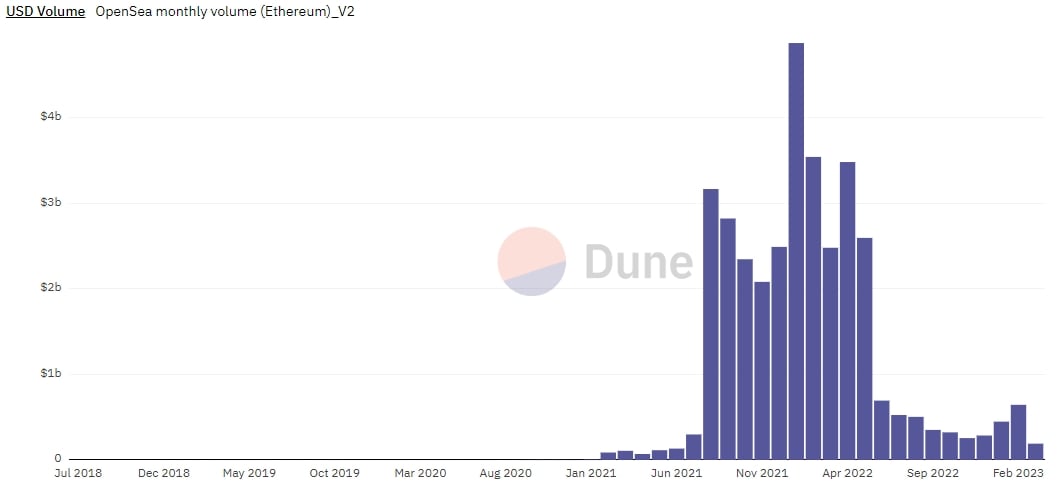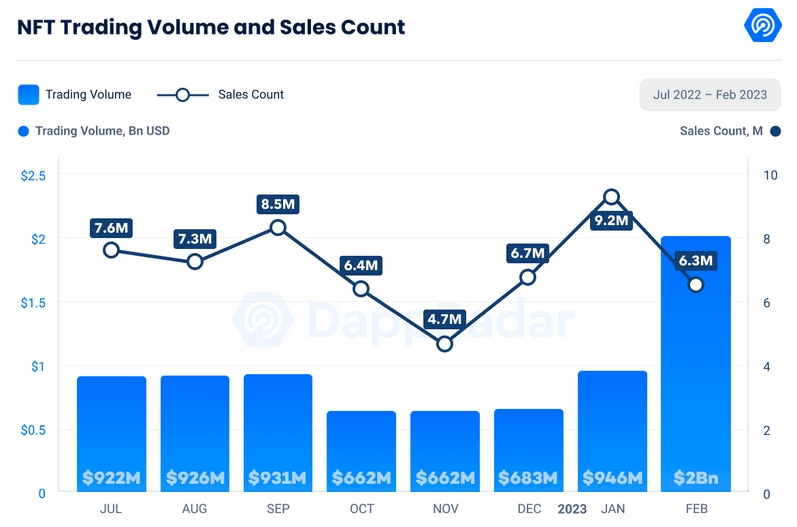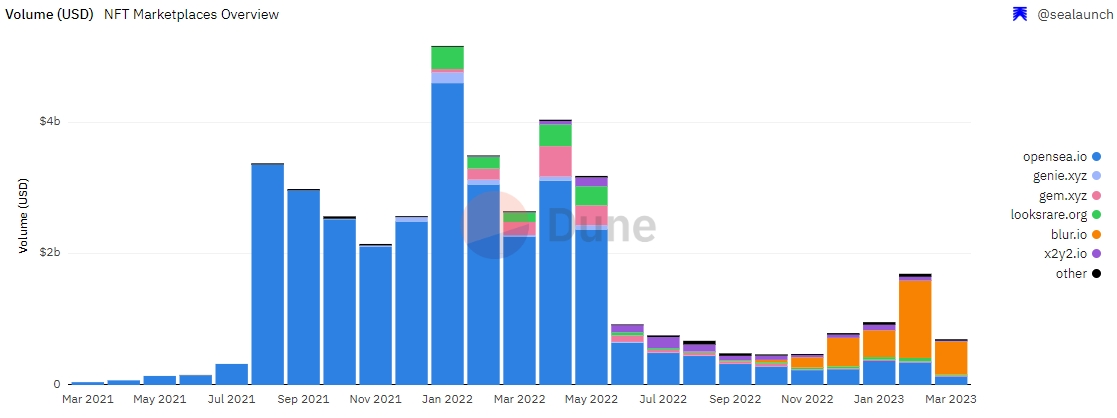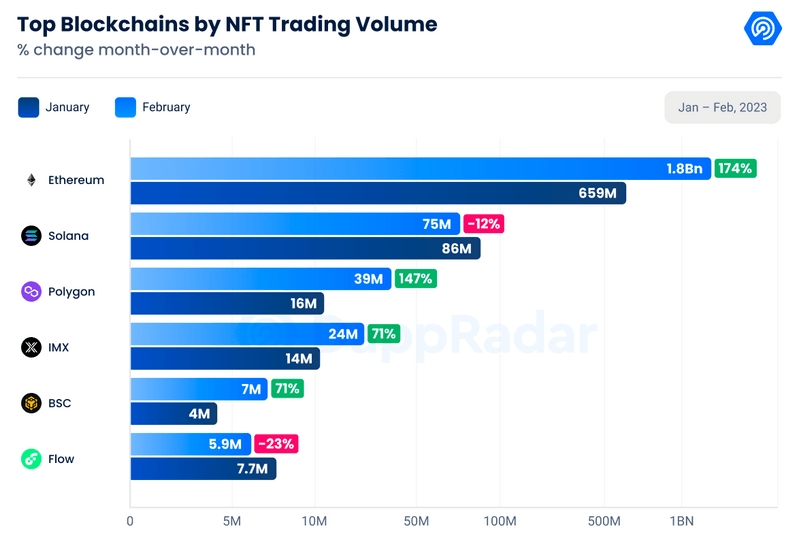In recent months, the NFT sector saw a massive decline in sales and item prices across the board. Still, the activity in the NFT space is still high and it would be wrong to say NFTs are dead, especially if we take into account the emergence of Blur as the most active NFT marketplace, a more than +100% increase in trading volume in February, and other indicators that show NFTs are here to stay.
There has been a growing debate about the sustainability of the NFT market and whether it is just a passing fad or a viable long-term investment. Some argue that NFTs are a bubble waiting to burst, while others believe they are here to stay and will revolutionize the way we think about ownership and authenticity in the digital world.
Related: What are NFTs and how do they work? Non-Fungible Tokens Explained
In this article, we will explore the current state of the NFT market, examine what could aid the recovery, and try to answer the question on everyone's mind: Are NFTs dead?
How we got here?
Last January, the world’s largest NFT marketplace, OpenSea, recorded a whopping $4.87 billion in NFT trading volume. At the time, the hype surrounding NFTs was at an all-time high, with mainstream celebrities like Eminem and Jimmy Falon supporting Bored Ape Yacht Club (BAYC) NFTs and other NFT projects.

NFT volume on OpenSea saw an extreme decline following the $4.87 billion peak in Q1 2022. Source
The market frenzy led to some NFTs reaching insane valuations, like Beeple’s digital photo collage selling for over $69 million and Pak’s “Clock” for $52 million. Now, roughly a year later, the situation is completely different, with no NFT selling for 7 figures or more in the past month (the highest-selling NFT in the period was Bored Ape Yacht Club #5116, which sold for $693,000 worth of ETH).
The biggest reason for the decline was the broader crypto market decline that saw Bitcoin, Ethereum, and most other digital assets lose high double digits since the November 2021 peak. NFTs were particularly hard hit, as many people outside of crypto became disillusioned with NFTs and saw no concrete reasons for the sky-high valuations ape NFTs and some other projects reached.
Also, many smaller projects were rug pulled by their creators, leading to unfounded accusations of all NFTs being scams and not worthy of investment. All in all, a combination of a crypto bear market and plummeting NFT sales created a particularly bearish environment.
However, with digital assets showing clear signs of recovery recently and Bitcoin reaching its nine-month high following encouraging inflation news, NFTs have also started trending in a positive direction.
Are NFTs dead? A deep dive into NFT stats
The most objective way to gauge the health of the NFT sector is to look at various trading data to see how much buying and selling is taking place on digital collectible marketplaces. This allows us to examine the current state of the NFT market and compare it to its historical performance.
NFT trading volume more than doubled to $2 bln in February

NFT trading volume spiked to $2 billion after failing to surpass $1 billion in the previous 7 months. Source: Dapp Radar
After months of declining trading volume, the trend reversed in January, with a +38.5% increase from the month prior. The spike in trading volume was even larger in February – it reached $2 billion, a +111% increase from the previous month.
According to NFT and DeFi analytics company Dapp Radar, the increase was driven by Blur, a new marketplace that took the NFT storm by storm in recent months. We’ll discuss Blur in more detail in the following section.
Interestingly, the increase in trading volume in February came despite an increase in the sales count, which dropped from 9.2 million in January to 6.3 million in February. That means that the average sale price of a traded NFT increased to account for the sizeable increase in trading volume.

In January 2022, a record $5.5 billion worth of NFTs changed hands across OpenSea and other major marketplaces. Source
While the spike in February was definitely impressive, the total trading volume is still a far cry from the record month recorded in January 2022, when over $5.5 billion worth of NFTs were traded across the major NFT marketplaces.
Top NFT chains: Ethereum leads the way, Solana is second
When NFTs first started gaining popularity, Ethereum was basically the only viable chain for issuing and trading NFTs. However, the high cost of transactions and low throughout left many digital collectors and artists wishing for a solution that would be faster and, most of all, cheaper.

Ethereum has an insurmountable lead over other blockchains in the NFT space. Source: Dapp Radar
Several other chains emerged that completed that role, but no other as successfully as Solana, which boasts one of the highest TPS in the industry and transactions that cost just a fraction of a penny (compared to Ethereum, where the cost for a single transaction had averaged ~$40 between Jan. 2021 and May 2022).
Nevertheless, Ethereum is clearly still enjoying its first-mover advantage as Dapp Radar data shows that Ethereum accounted for $1.8 billion in trading volume in February. The second most active chain was Solana, which accounted for $75 million. Despite the big gap between the two, Magic Eden and other top Solana NFT marketplaces have been gaining in popularity recently.
Blur overtakes OpenSea in terms of trading volume
The Blur NFT marketplace launched in mid-October 2022 and quickly started gaining traction among NFT collectors and traders. However, it wasn’t until February that the marketplace exploded in popularity, overtaking OpenSea as the largest NFT marketplace in the meantime.
The reason for the February surge was the airdrop event for the BLUR token. BLUR was airdropped to loyal Blur users, meaning that only those users who used the Blur marketplace exclusively to list NFTs were eligible to receive the maximum airdrop amount. That introduced a clear incentive for NFT users to choose Blur over OpenSea and other marketplaces that don’t have similar incentive mechanisms in play.
Blur has emerged as the largest NFT marketplace in recent weeks. Source
It’s hard to estimate how big of an impact the launch of BLUR had on the broader NFT market, but the rise in trading volume clearly coincided with the launch of the token.
Why NFTs could become more popular in the future
While NFTs are primarily known for their use for expensive profile pictures, the potential of NFTs is far greater, as they can be used for a variety of purposes across different sectors, including digital art, music, games, and more. Here are several reasons why NFTs could recover and become more popular in the future:
- Development of infrastructure: As the technology behind NFTs continues to improve and become more accessible, it could attract more investors and buyers to the market.
- Scarcity: NFTs are unique and cannot be duplicated, which makes them inherently scarce. As more people want to own a particular NFT, the price could increase due to the limited supply.
- Diversification: NFTs offer a unique opportunity to invest in digital assets, which is a relatively new and unexplored area. As investors seek to diversify their portfolios, they may look to include NFTs as part of their investment strategy.
- Growing adoption: NFTs have gained a lot of attention in recent years due to the growing interest in digital art and collectibles. However, the gaming sector and other uses have remained relatively untapped but could provide a massive boost to NFTs in the future.
- Increasing acceptance: More and more mainstream artists and brands are starting to create and sell NFTs. Increasing acceptance could lead to more people buying and trading NFTs, thus driving up their value.
While there are no guarantees that NFTs will recover in the future, the factors mentioned above suggest that there is potential for growth in the NFT market. However, as with any investment, it is important to realize the inherent risks, which are all the more pronounced with nascent assets like NFTs. At this point, we can only wait and see how things will play out.
The bottom line: No, NFTs are not dead – but they have been on a clear decline
After May 2022, the trading volume of NFTs plummeted for a variety of reasons, but primarily due to the broader crypto winter. With the crypto market showing renewed bullish activity in the first quarter of 2023, NFTs saw a major spike in activity, recording $2 billion in volume in February, up from $946 million the month before.
Anyway you slice it, saying that an industry clearing $2 billion in trading volume per month is dead would be a big stretch. However, there’s no denying that the NFT sector is currently far from its peak popularity in late 2021 and early 2022.
If you want to read more about NFTs, check how The Merge NFT raised over $90,000,000 and became the highest-grossing NFT collection ever, or our piece on how Logan Paul spent $623,000 on an NFT that is now worth just $10.
 coincodex.com
coincodex.com